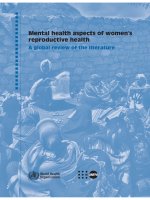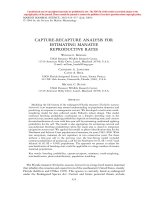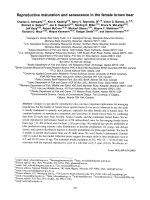Reproductive Physiology The Male Reproductive System ppt
Bạn đang xem bản rút gọn của tài liệu. Xem và tải ngay bản đầy đủ của tài liệu tại đây (1.23 MB, 37 trang )
Reproductive Physiology
The Male Reproductive System
Dr. Khalid Al-Regaiey
Sex Determination: Overview
• Bipotential tissues: genes & hormones direct
differentiation
• Gonad testis or ovary
• Wolffian duct Vas deferens,
• Mullerian duct oviduct
Sexual Differentiation: Internal Embryonic Development
Sexual Differentiation: Internal Embryonic Development
Sexual Differentiation: External Genitalia
Male Development
Role of hCG in Male Development
• Human chorionic gonadotropin (hCG) which is
secreted by the placenta has LH-like effects
• If the fetus is male, hCG stimulates testosterone
production from the testes of the fetus which
helps in development of male sexual organs
Regulation of Reproduction: General Pathways
• Hypothalamus: pulse generator
• Gonadotropin releasing H
• (GnRH)
• Anterior Pituitary
• Lutenizing H (LH)
• Follicle stimulating H (FSH)
• Ovary: progesterone
• Estrogen, inhibin
• Testis: testosterone
Regulation of Reproduction: General Pathways
Male Reproductive System
Male Reproductive Anatomy and Physiology
• Testis
• Epididymis
• Vas deferens
• Seminal vesicle
• Prostate
• Bulbourethral
• Ejaculatory duct
• Urethra
• Penis
Male Reproductive Anatomy
The Male Reproductive System in Anterior View
The Structure of the Testes
• Takes about 74 days
• Seminiferous tubules
• Contain spermatogonia
• Stem (germ) cells involved in
spermatogenesis
• Contain Sertoli cells
• Sustain and promote development of sperm
Spermatogenesis
The Seminiferous Tubules
The Seminiferous Tubules
Sertoli cells
Leydig cells
Spermatogenesis
(2N)
(4N)
(2N)
(1N)
Spermiogenesis and Spermatozoon Structure
Spermatozoa Structure and Functions in Review
• Head
• Acrosome: formed from
Golgi apparatus, contains
proteolytic enzymes
• Nucleus
• Midpiece
• Centrioles:
• Mitochondria:
• Tail: flagellum
• Microtubules:
• GnRH LH Leydig cells testosterone
growth and division of germ cells
• GnRH FSH Sertoli cells spermatoctye
maturation
• Inhibin feedback – FSH, testosterone – short &
long loops
Regulation of Spermatogenesis
Regulation of Spermatogenesis
Maturation of Sperm in Epididymis
• Sperms in the early portion of epididymis are
nonmotile
• After 18-24 h they develop capability of motility
• Most of sperms are stored in vas deferens,
maintaining their fertility for at least a month
• After ejaculation they become motile
• Activity of a sperm is greatly enhanced in neutral
to slightly alkaline medium and depressed in
acidic medium
• The life expectancy of ejaculated sperm in the
female genital tract is 1-2 days
Seminal Vesicles
• S Vs produce nutrients as well as prostaglandins
and fibrinogen
Prostate
• Slightly alkaline milky fluids that help in
neutralizing other seminal fluids as well as the
vaginal fluids
• Prostates fluids also contain clotting protein and
profibrinolysin
Semen
• Milky white, sticky mixture of sperm and accessory
gland secretions:
• Sperm and fluid from vas deferens 10%
• Seminal plasma (70% seminal vesicles, 20%
prostate, and small amounts from other glands)
• Provides a transport medium and nutrients
(fructose), protects and activates sperm, and
facilitates their movement
• Average pH is 7.5









